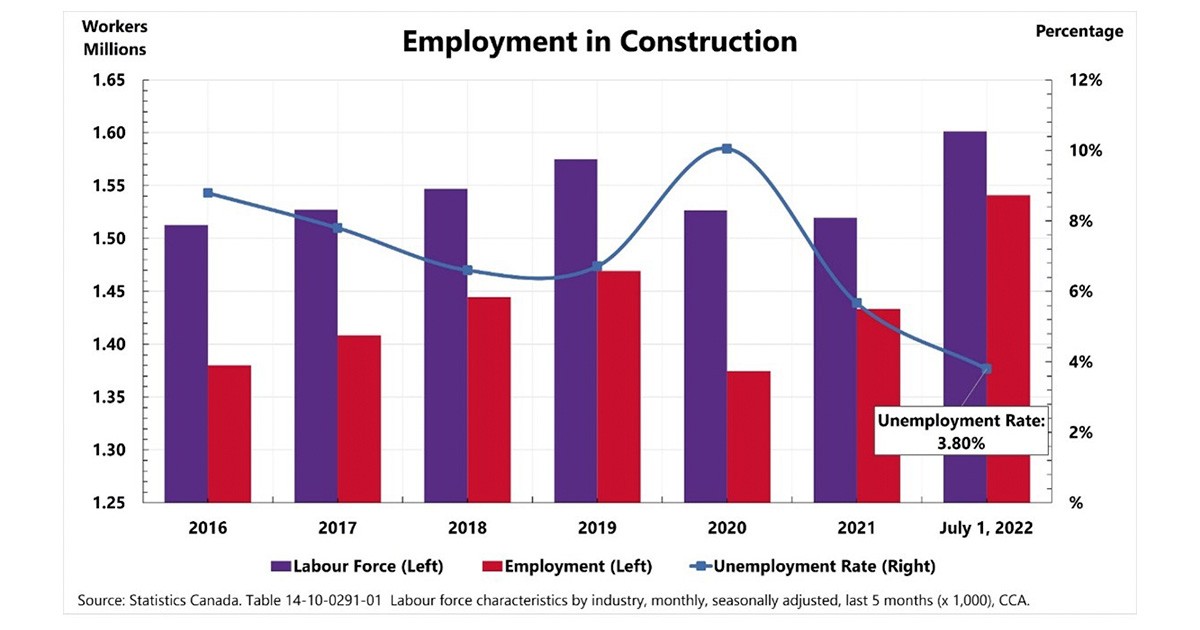Association sounds alarm over historic job vacancy rates
Mary Van Buren: ‘Nearly 1 million jobs are unfilled’

The Site C Dam project in B.C. has more than 5,000 workers on site. – BC Hydro
Key Takeaways:
- Construction recorded its lowest ever level of unemployment this summer.
- BuildForce Canada anticipates 113,000 workers will need to be added by 2027.
- To address the issue, the CCA has been working on a series of recruitment initiatives and is calling on government to take action.
The Whole Story:
The Canadian Construction Association (CCA) is sounding the alarm on unprecedented demand for scarce construction labour.
“Canada is facing its most severe labour shortage in over 50 years – nearly 1 million jobs are unfilled,” said Mary Van Buren, CCA president, in a statement to media. “The situation is especially acute for the construction sector – we have over 81,000 openings now. This also means the essential infrastructure projects that 38 million Canadians rely on every day risk being cancelled or delayed.”
The CCA urged everyone in the industry to join its ‘Rebuild Canada’s workforce NOW’ campaign. The campaign will see industry representatives meet with parliamentarians for CCA’s Hill Day on Nov. 15 where they will urge the federal government to:
- modernize Canada’s immigration policy and point system to better recognize tradespeople and construction labourers.
- work with the provinces to ensure skills matching is properly funded and supported; and
- update the Temporary Foreign Worker program to allow seamless access for the construction industry.
The group stated that the demand for labour in non-residential construction is increasing thanks to the post-pandemic boom experienced by the construction industry.
The CCA cited data that shows job vacancies currently sitting at 84,585 while the value of monthly building permits reaching $3.9 billion. That’s a 17 per cent increase over its highest recorded level seen since 2019.
BuildForce Canada forecasts that given the current demand for non-residential construction, the industry will need to add 113,100 workers by 2027. The first 35,500 workers will be needed to meet the rising demand, while the remaining 77,600 are required to make up for the same number of workers set to retire over the same period.

“This may prove difficult in current market conditions,” said the CCA in an announcement, noting that a July report by Statistics Canada the construction industry documented its lowest ever level of unemployment.
“Low levels of unemployment indicate the supply of workers is insufficient to fill current vacancies,” said the association. “Given this trend, the construction industry is already facing the negative impacts of low unemployment, which include greater difficulties in recruitment and retention, lower productivity gains, and rapid wage growth.”
The group added that the construction sector contributes $152 billion, or 7.5 per cent of Canada’s GDP, annually.
“The industry has immense growth potential but is facing fierce competition for talent,” CCA officials said.
CCA has been working on several initiatives to build a pipeline of skilled, unskilled, and professional talent. Our Talent Fits Here initiative is a national public awareness campaign designed to attract workers by positioning construction as a career of choice. The association is also advocating for changes to the Canadian immigration system to facilitate the entry of skilled immigrants interested in working in the construction sector.
“The future of Canada’s economic growth depends on our ability to attract, develop, and retain top talent,” they said.
